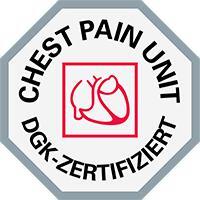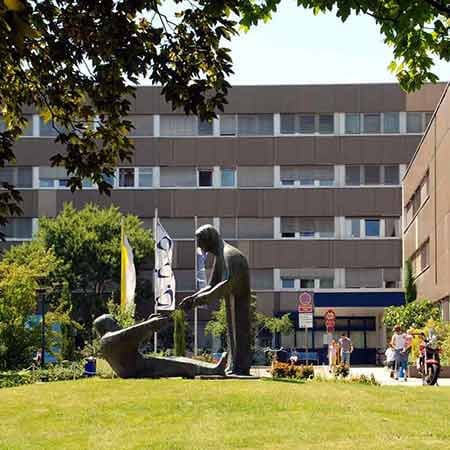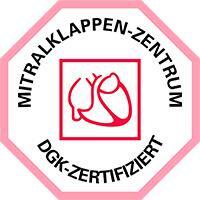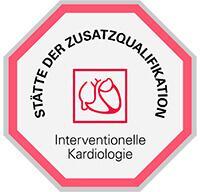Pulmonary Valve Stenosis — Pulmonary Valve Balloon Valvuloplasty: treatment in the Best Hospitals of Germany
Treatment prices are regulated by national law of the corresponding countries, but can also include additional hospital coefficients. In order to receive the individual cost calculation, please send us the request and medical records.

Department of Cardiology and Pulmonology
The Department of Cardiology and Pulmonology provides the full range of diagnostic and therapeutic services for patients with diseases of the cardiovascular system and lungs. In the field of cardiology, key attention is paid to the treatment of valvular heart disease, arrhythmias, heart failure, coronary artery disease, arterial hypertension and aortic diseases. The department's pulmonologists mostly deal with the treatment of pneumonia, bronchial asthma and chronic obstructive pulmonary disease. In addition, the department operates an Intensive Care Unit, within which patients can receive artificial ventilation, renal replacement therapy and procedures for maintenance of blood flow. The department's Chest Pain Unit is certified by the German Cardiac Society and provides medical care to patients with acute coronary syndrome. The department successfully uses in its clinical practice both proven classical treatments and innovative medical achievements, which are available only in leading European hospitals. The department's medical team provides treatment to more than 3,200 patients every year.




Department of Cardiology and Angiology
The Department of Cardiology and Angiology offers the full range of medical services in the fields of its competence. The department's doctors specialize in the treatment of congenital and acquired heart defects. The key focus is on catheter-based heart interventions, which are characterized by a minimal trauma rate and allow patients to avoid an open operation. For this purpose, the department has three modern Cardiac Catheterization Laboratories. The department also houses an Intensive Care Unit and a Chest Pain Unit for patients with acute coronary syndrome. The medical facility has 82 beds. The department was awarded the prestigious quality certificate from the German Cardiac Society (DGK) for outstanding results in the treatment of mitral valve diseases and acute coronary syndrome. Another important area of work of the department's physicians is comprehensive heart examinations for the prevention of heart disease. For this purpose, specialized Check Up Programs have been developed here, which include an optimal set of diagnostic tests. The medical facility employs a highly professional team of doctors and nursing staff, which makes every effort to provide each patient with effective medical care in a pleasant and comfortable atmosphere.






Department of Cardiology and Angiology
The Department of Cardiology and Angiology offers the full range of medical services in the areas of its specialization. The medical facility holds consultations and carries out the diagnostics and treatment of diseases of the heart and blood vessels. The department's team of cardiologists focuses on patients with valvular heart disease, heart rhythm disturbances, coronary artery disease, heart failure, and congenital heart disease. The department has a Chest Pain Unit certified by the German Cardiac Society (DGK) for the treatment of acute coronary syndrome. In the field of angiology, of key interest is the treatment of peripheral arterial occlusive disease, vascular stenosis of various locations, including carotid artery stenosis, and deep vein thrombosis. During the treatment of diseases of the heart and blood vessels, the department’s specialists use various drug therapy regimens and perform image-guided interventional procedures. The medical facility has been recognized with quality certificates for transcatheter aortic valve implantation (TAVI) and treatment of heart failure and mitral valve disease. Patients are treated by highly qualified physicians who strive to restore the patient's health using sparing treatment methods.






Until recently, the main treatment for pulmonary valve stenosis was surgery. It had to be performed through a large incision in the chest using a heart-lung machine. However, traumatic operations are no longer required today. Pulmonary valve stenosis can be successfully treated with a minimally invasive procedure. It is performed through a small incision in the groin. Moreover, minimally invasive interventions are effective in adults and children of all ages and do not require a long recovery. You can undergo your pulmonary valve balloon valvuloplasty in Germany and expect good long-term results.
Content
The procedure is performed through a small incision in the leg from inside the blood vessels under X-ray (angiography) guidance. No incisions in the chest are required. The treatment technique is minimally invasive and safe. And what is more, patients recover quickly after the procedure.
You can seek medical attention at the University Hospital Ulm, the University Hospital Essen, or the University Hospital Oldenburg.
The Booking Health company will take care of all the arrangements for your trip. We will contact the hospital administration and schedule an appointment for you on the dates you specify. We will also translate your medical records into German, book airline tickets and a hotel room, meet you at the German airport, and take you to the hospital by car.
Who may need a balloon valvuloplasty?
Balloon repair is the first choice for treating pulmonary valve stenosis. This is one of the most common congenital malformations in children. The procedure is performed with a gradient (difference) of systolic pressure (at the time of heart contraction) between the right ventricle and the pulmonary trunk of 50 mmHg and more.
A balloon valvuloplasty has many advantages over valve replacement:
- minimally invasive procedure;
- minimal health risks;
- shorter recovery time;
- no need to take anticoagulants;
- revision interventions will not be required in the future due to the wear of the artificial valve.
How is a balloon valvuloplasty performed?
The vascular bed is approached through the femoral vein or, less frequently, through the jugular vein. A physician makes a skin incision, after which he inserts a vascular introducer to provide a permanent approach. A guidewire is inserted through the introducer to insert a catheter. Angiography is then performed, during which a contrast agent is injected into the blood vessels and X-rays are made. The pressure in the right ventricle is measured.
Cardiosurgery doctors deliver the guidewire to the pulmonary trunk and place it in one of the pulmonary arteries. The catheter is then removed, and the balloon is delivered along the guidewire. Its middle is placed in the area of stenosis. The balloon is inflated using a syringe and a manometer by injecting a saline-containing liquid into it. The disappearance of the "waist" of the balloon indicates that the procedure was a success and the stenosis was eliminated.
The double balloon valvuloplasty technique can also be used. In this case, doctors catheterize two veins, after which two balloons are placed into the stenosis area. The technique is suitable for patients with large vascular ring diameters.
You are welcome to use the Booking Health service to undergo your pulmonary valve stenosis treatment in Germany. This procedure is available at the best hospitals with cardiosurgery departments, with high success rates and a minimal risk of complications. On the Booking Health website, you can find out the cost of treatment, compare prices at different cardiosurgery departments in Germany, and choose the most favorable option. Our specialists will help you select the most suitable clinics and arrange your trip.
Authors:
The article was edited by medical experts, board-certified doctors Dr. Nadezhda Ivanisova and Dr. Vadim Zhiliuk. For the treatment of the conditions referred to in the article, you must consult a doctor; the information in the article is not intended for self-medication!
Sources:

